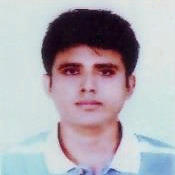
Abdullah-Al Nahid
Work place: Electronics and Communication Engineering Discipline, Khulna University, Khulna-9208, Bangladesh
E-mail: nahid.ece.ku@gmail.com
Website:
Research Interests: Medical Image Computing, Image Processing, Computational Learning Theory
Biography
Dr. Abdullah-Al Nahid is currently working as Professor in Department of Electronics and Communication Engineering, Khulna University, Khulna, Bangladesh. He received the B.Sc. degree in Electronics and Communication Engineering from Khulna University, Khulna, Bangladesh, in 2007, the M.Sc. degree in telecommunication engineering from the Institute for the Telecommunication Research (ITR), University of South Australia (UniSA), Australia, in 2014, and the Ph.D. degree from Macquarie University, Sydney Australia, in 2018. His research interests include machine learning, biomedical image processing, data classification, and smart grid.
Author Articles
A Comprehensive Bibliometric Study on Machine Learning Based Rehabilitation and Stroke Research (1999 - 2022)
By Tasfia Tahsin Humayra Akter Uzzal Biswas Jun Jiat Tiang Abdullah-Al Nahid
DOI: https://doi.org/10.5815/ijem.2025.01.02, Pub. Date: 8 Feb. 2025
In recent years, the rising prevalence of chronic illness has led to an increase in disability of patients. Extensive research has been done to enhance both the functional abilities as well as the quality of the affected individuals’ lives. Researchers have worked on the effects of numerous scholars, keywords and countries of these specific fields. However, a few state-of-the-art bibliometric analyses have been done in this research to reduce the quantitative aspects of the vast research fields of rehabilitation. We have precisely selected 427 core papers from the Web of Science database spanning from 1999 to 2022 where Machine Learning (ML) or Deep Learning (DL) is used in the rehabilitation field. Consequently, our analysis focuses on citation patterns, trend analysis and collaborations between countries or influential keywords offering a detailed overview of global trends in this interdisciplinary domain. Additionally, we visualize the research trends of various authors and countries which provide invaluable insights into research impact as well as collaboration networks. Overall, this paper aims to shape the evolving field of rehabilitation by providing in depth analysis of the citation landscape, key researchers, and international collaborations.
[...] Read more.Home Occupancy Classification Using Machine Learning Techniques along with Feature Selection
By Abdullah-Al Nahid Niloy Sikder Mahmudul Hasan Abid Rafia Nishat Toma Iffat Ara Talin Lasker Ershad Ali
DOI: https://doi.org/10.5815/ijem.2022.03.04, Pub. Date: 8 Jun. 2022
Monitoring systems for electrical appliances have gained massive popularity nowadays. These frameworks can provide consumers with helpful information for energy consumption. Non-intrusive load monitoring (NILM) is the most common method for monitoring a household’s energy profile. This research presents an optimized approach for identifying load needs and improving the identification of NILM occupancy surveillance. Our study suggested implementing a dimensionality reduction algorithm, popularly known as genetic algorithm (GA) along with XGBoost, for optimized occupancy monitoring. This exclusive model can masterly anticipate the usage of appliances with a significantly reduced number of voltage-current characteristics. The proposed NILM approach pre-processed the collected data and validated the anticipation performance by comparing the outcomes with the raw dataset’s performance metrics. While reducing dimensionality from 480 to 238 features, our GA-based NILM approach accomplished the same performance score in terms of accuracy (73%), recall (81%), ROC-AUC Score (0.81), and PR-AUC Score (0.81) like the original dataset. This study demonstrates that introducing GA in NILM techniques can contribute remarkably to reduce computational complexity without compromising performance.
[...] Read more.Other Articles
Subscribe to receive issue release notifications and newsletters from MECS Press journals